The 2019/20 Ligue 2 season has been nothing but exciting to watch right from the start. The race to get into promotion and playoffs spots have been very tight and even up until week 28, you can’t really predict which team are going to get automatic promotion or have to go the playoffs first. Table-toppers Lorient alongside runners-up Lens gained automatic promotion to Ligue 1 after it was announced that the season will be wrapped up prematurely. Each team have 54 and 53 points respectively.
Unfortunately for Olivier Pantaloni and his ambitious Ajaccio side, they missed out on automatic promotion by a tiny margin. Ajaccio finished the season with 52 points – just one point away from automatic promotion. Looking at how impressive they have been this season, they may even end up finishing top of the table if the season is resumed. But their journey ended there. With the promotion and relegation playoffs cancelled, the third, fourth, and fifth-placed teams, as well as the 18th-placed team in Ligue 2, will be staying in the league for another season.
Pantaloni’s Ajaccio have been very strong throughout the season with their direct yet effective attack as well as highly intense and aggressive defence. We’re going to take a look at Pantaloni’s philosophy and tactics at Ajaccio this season in this tactical analysis.
Overview
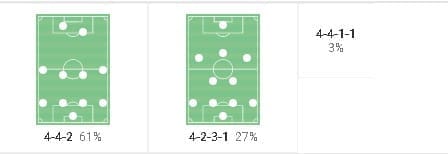
Throughout the season Pantaloni is very consistent with his team’s formation. He mainly used 4-4-2 but may tweak it slightly, turning it into more of a 4-2-3-1 or a 4-4-1-1. Since taking charge of Ajaccio in the 2014/15 season, Pantaloni has been persistent in using back-four formations and he doesn’t seem to experiment a lot with various shapes and formations other than 4-4-2, 4-2-3-1, 4-4-1-1, and 4-3-3 (used occasionally in the previous seasons).
In general, his team seem to be keen on maintaining formation, especially in defence. In offence, the overall team shape is pretty flexible but unlike PSG, for example, whose front-four are very flexible and constantly rotate and swap positions, Ajaccio’s strikers don’t swap positions often with the wingers although at times they can be seen roaming wide and receiving the ball in wide areas. More on this later in this analysis.
Pantaloni also wants his team to work together as a team in every phase of the game. Defenders will be asked to participate in attack if needed and strikers are also expected to actively get involved in defence. High intensity, high aggression, high work rate and discipline are the things that first came to mind upon seeing Ajaccio play.
In terms of player choices, Pantaloni likes using a sweeper-keeper at the back in the form of Benjamin Leroy. This perfectly suits his team’s aggressive high-pressing approach. With the defensive line usually staying high, there’s an abundance of space behind the defence. Leroy is tasked to sweep up through passes or loose balls in the back of the defence.
Ajaccio look to play from the back so Pantaloni likes to have two centre-backs with good ball-playing ability in his team. Cédric Avinel has been the main choice in the right centre-back berth this season while Jérémy Choplin (prior to moving to Le Mans in the winter transfer window) and Ismaël Chester Diallo rotated playing in the left centre-back spot.
Pantaloni seems to like playing full-backs who have pretty decent ball-playing ability and are strong in defence. They don’t necessarily have to be aggressive in attack and don’t need to have strong chance creation ability though. Signed from Ligue 1 sides Rennes and Olympique Lyonnais respectively, Matthieu Huard and Gédéon Kalulu have been outstanding this season and both have also been very consistent throughout the season.
In the midfield, Qazim Laçi and Mathieu Coutadeur have formed a very strong partnership in the centre-midfield spot. Both players are dynamic and can offer a lot in the final, middle, and defensive third. Both have impressive work rate, excellent passing ability and vision, and are strong and composed on the ball. Both are also highly energetic and aggressive in defence which perfectly suits Pantaloni’s needs.
On the wings Lens loanee Cyrille Bayala is pretty much irreplaceable in the right side of the flank. Meanwhile, 2000-born talented winger Matteo Tramoni is currently enjoying a very impressive and stable season with the senior side. While Tramoni may occasionally rotate with Lille loanee Alexis Flips, Tramoni is still Pantaloni’s main choice in the left flank.
Finally, Pantaloni likes to have two athletic yet dynamic strikers. Gaëtan Courtet has been the main choice in this position whilst Hugo Cuypers is usually rotated with Mounaïm El Idrissy.
Direct and quick but well-calculated
Pantaloni’s Ajaccio are unique. They’re both flexible but also quite rigid. They’re both patient and also direct and quick. Their style of play is quite similar to that of Christophe Galtier’s Lille. Both teams are very aggressive and intense in defence and look to break forward quickly in counter-attack once they win the ball. Both teams mainly look to start from the back and will try to patiently play their way out of pressure rather than rushing it forward with long passes.
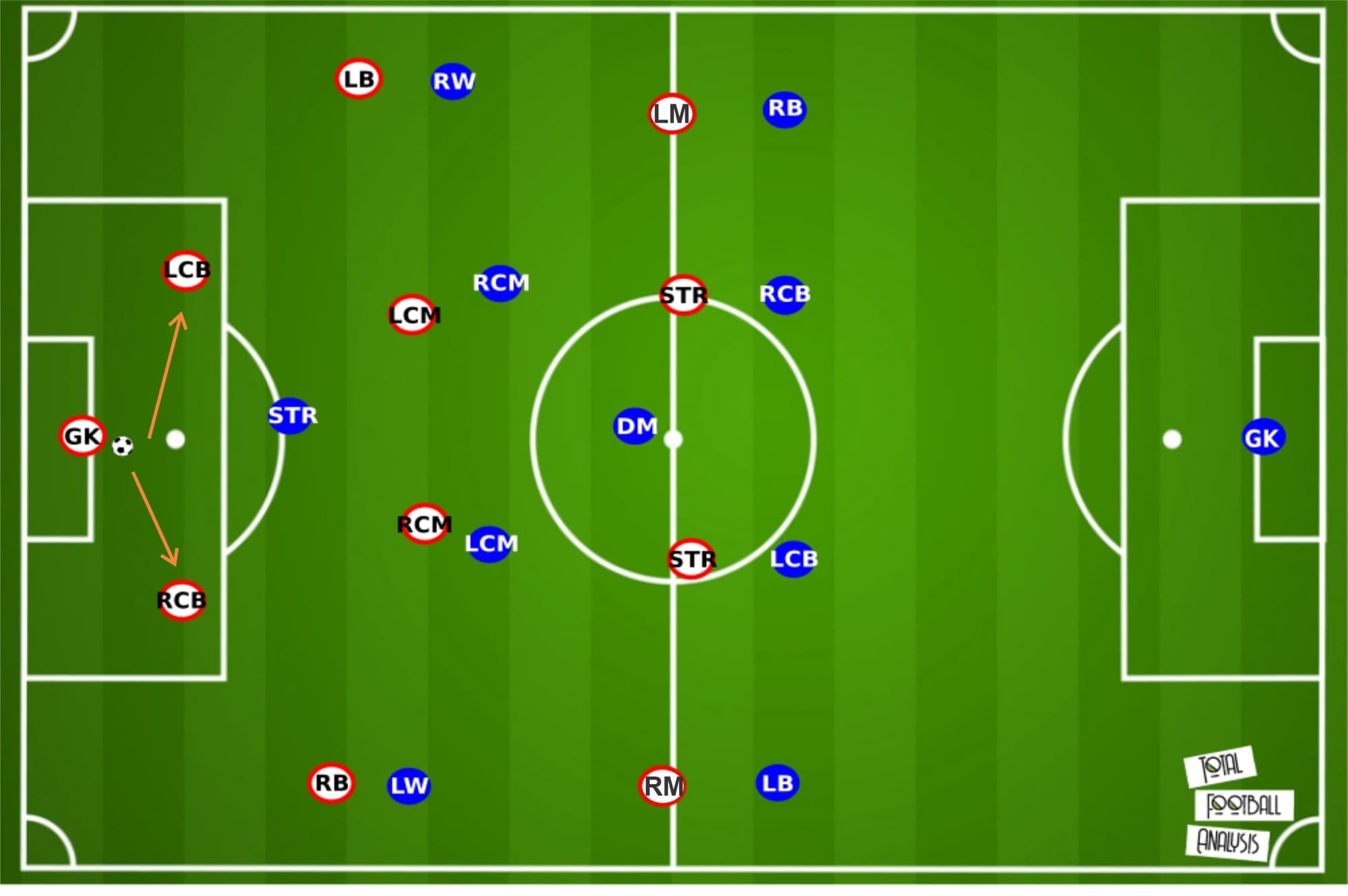
Above you can see Ajaccio’s shape at the start of their build-up phase. Centre-backs sit a bit narrower and closer to the goalkeeper. Meanwhile, the full-backs sit deep rather than move higher up the pitch in the build-up phase. The two central midfielders sit in front of the backline. Usually, one will drop to offer support while the other centre-mid will move forward instead and try to find pockets of space to exploit. If needed though, both centre-mids will drop and offer support.
The goalkeeper will usually start with a short kick towards either centre-back rather than playing it long. From there, they’ll try to work their way out of pressure.
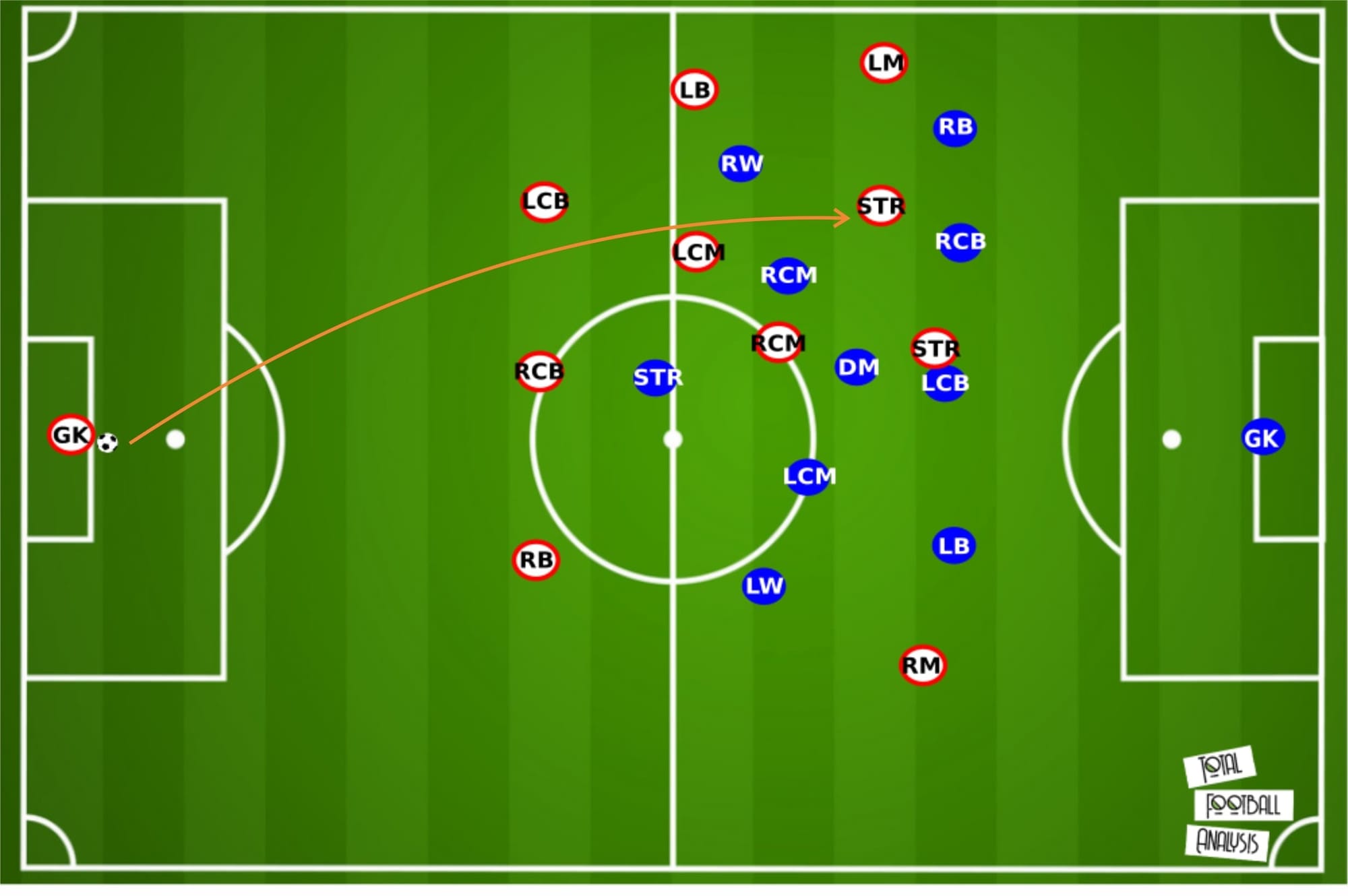
At times, however, Ajaccio may look to start with a long distribution instead from the goal-kick. This usually happens whenever they face teams who press high and are very aggressive in their approach. If they see that it’s too risky to play from the back, then they’ll start long instead.
The goalkeeper usually will try to deliver the ball towards one of the two strikers (mainly the one with the strongest aerial ability). Above you can see how the players positions themselves in preparation for the long goal-kick. Ajaccio players will surround the area not only to give the striker options to lay the ball off to but also to prepare to fight for the second ball.
In attack, Pantaloni’s side mainly rely on width, verticality, and pace in attack. They’ll mostly look to play through the half-spaces and flanks in order to break into the opposing team’s defence. However, when it comes to creating chances, they don’t limit themselves to just creating chances from wide channels and wide areas. Often the ball will be moved back to central area before a killer pass is played.

In the image above you can see Ajaccio’s positional attack tendencies. You can see that they mainly attack and create goalscoring chances from wide areas but there are also a few chances created from central areas.
In terms of passing, Pantaloni’s side don’t restrict themselves to only using short passes but also don’t rely too much on long balls. Pantaloni seems to encourage his men to play with high tempo and take some risks. Players mainly look to attempt quick short combinations in order to move the ball around or progress it forward, but if there’s a chance to play a long ball towards the other side of the field or towards the back of the opposing team’s defence then the ball carrier will usually take it.
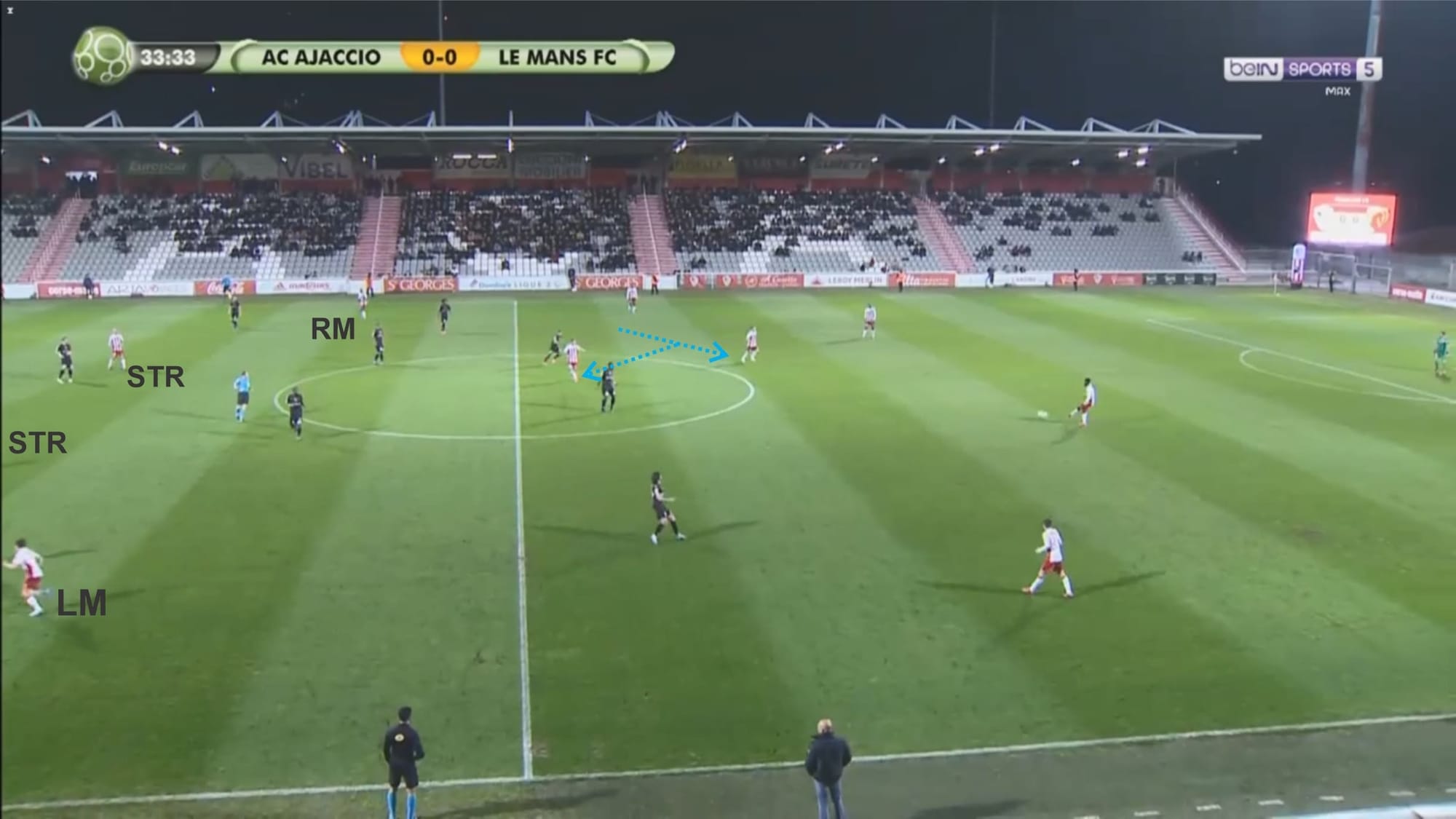
Above you can see Ajaccio’s structure in the build-up. Two full-backs sit deep while the two wide midfielders maintain width rather than tucking in and allowing the two full-backs to sit high and occupy the flanks. The two Ajaccio strikers actively move in advanced areas. Often while one striker drops to receive, the other striker makes a run in behind the defence. The two central midfielders are also flexible. As mentioned earlier in this section, while one central midfielder may drop to close down the ball carrier and offer passing option, the other will move forward and look for pockets of space in between the first and second line or second and third line of opposing team’s defence.
When playing from the back, Ajaccio look to move the ball from side to side. Now there are several commons situations that may occur in their build-up.
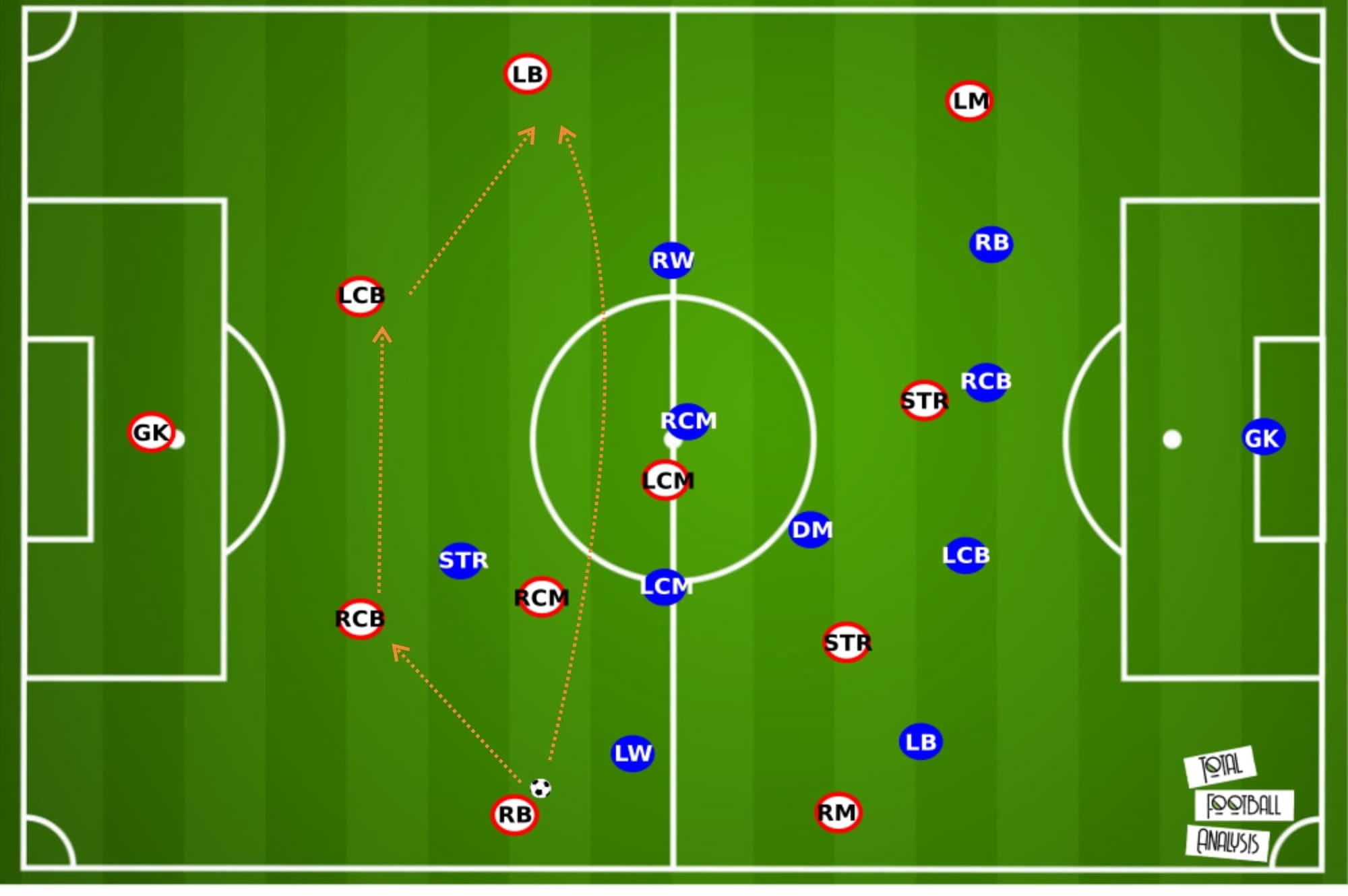
If the ball carrier can’t find any good option to progress the ball then he may try to switch the play via long lateral/diagonal pass or via U-pattern passing as you can see in the image above. There are also several things that you may notice in the image above. You can see that if the ball is moved towards one side of the pitch, both central midfielders will move closer towards that area in order to help create an overload in that particular area. Their positions are still dynamic with one centre-mid sitting higher than the other one. You can also see that the ball-side striker and winger both dropped to make themselves available as passing options. Reaching either player (striker or winger), however, may be difficult as upon receiving the ball, the right-back may receive intense pressure from the opposing winger, so he needs to turn and play the ball quickly before the opposing winger closes him down and cuts of his passing lanes.
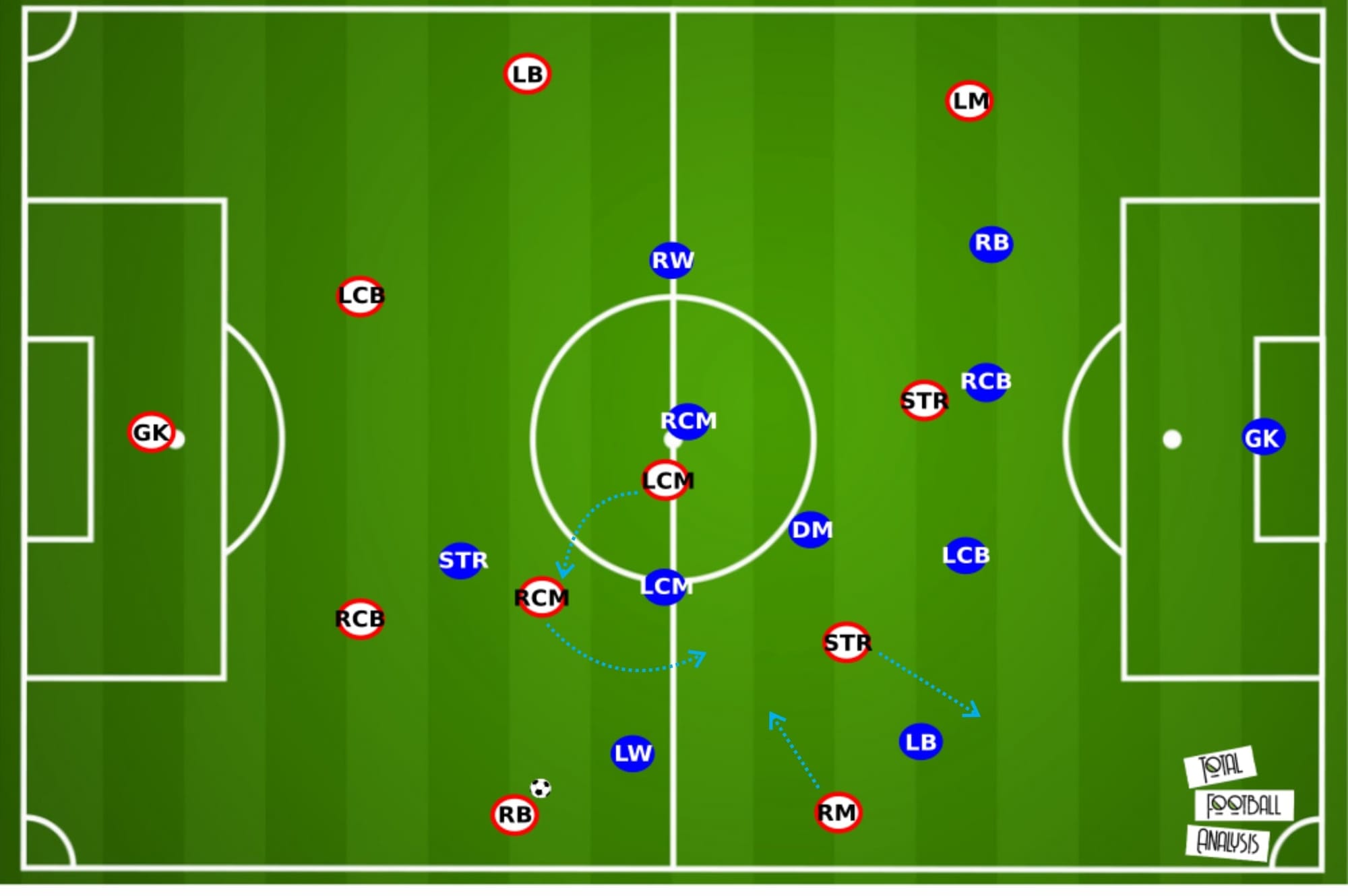
Another thing that could potentially happen is that the right central midfielder will move forward and drag his marker away, opening up passing lane towards the left central midfielder who moves to fill the spot that was vacated by the right central midfielder. The right midfielder will then look to drop further and occupy the half-space while the ball-side striker will look to move wider and occupy the right flank. This will create a dilemma for the opposing left-back where he needs to decide whether to sit back and mark the striker or jump out and follow the winger. Either way, Ajaccio can still benefit from the dilemma. Once the ball is played towards the left central midfielder, he may in turn play the ball towards the winger who’s free in the half-space or (in case the winger is marked) play the ball towards the free striker on the flank.
You can see from the situation above that Ajaccio rely a lot on opposite movements to create separations. These opposite movements may be created individually or collectively and these movements are very effective to disrupt the opposing team’s defensive structure. Ajaccio players also tend to play with fewer touches, preferring to move the ball quickly upon receiving it in order to limit the opposing team’s time to press them. Furthermore, passing triangles and third-man runs are very common in Ajaccio’s attack. An example of that can be seen below.
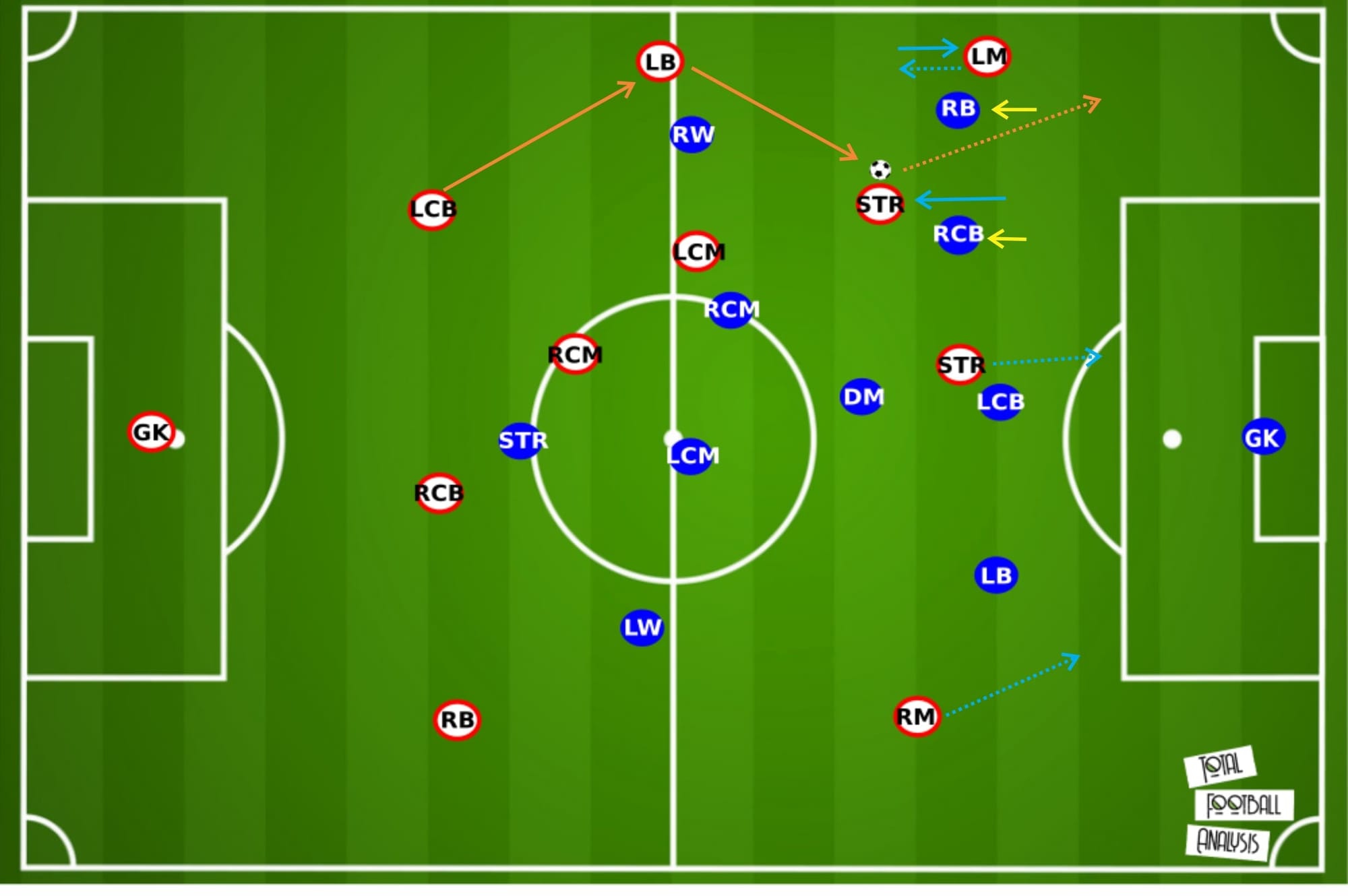
In the image above, for example, the left centre-back gives the ball to the left-back. Upon seeing the left-back receiving the ball, the left midfielder will drop to offer support whilst also dragging out the opposing right-back. The striker also sees an opportunity to drop and receive in receive the ball in space in front of the opposing backline.
The left-back passes the ball into the feet of the striker and the left midfielder quickly turns towards the opposite direction and runs into space behind his man. The striker then plays the ball onto the path of the unmarked left midfielder who can cross the ball towards the centre/near-post for the ball-far striker or towards the far-post for the right midfielder. The ball-near striker will also make a run after playing the pass and usually will arrive a bit late in the box so he can also potentially receive the ball if the left midfielder delivers a cutback cross.
Aside from the aforementioned ways to play out of pressure and attack, there are several other pretty common moves that Ajaccio players may execute in order to work their way out of pressure and get the ball forward.
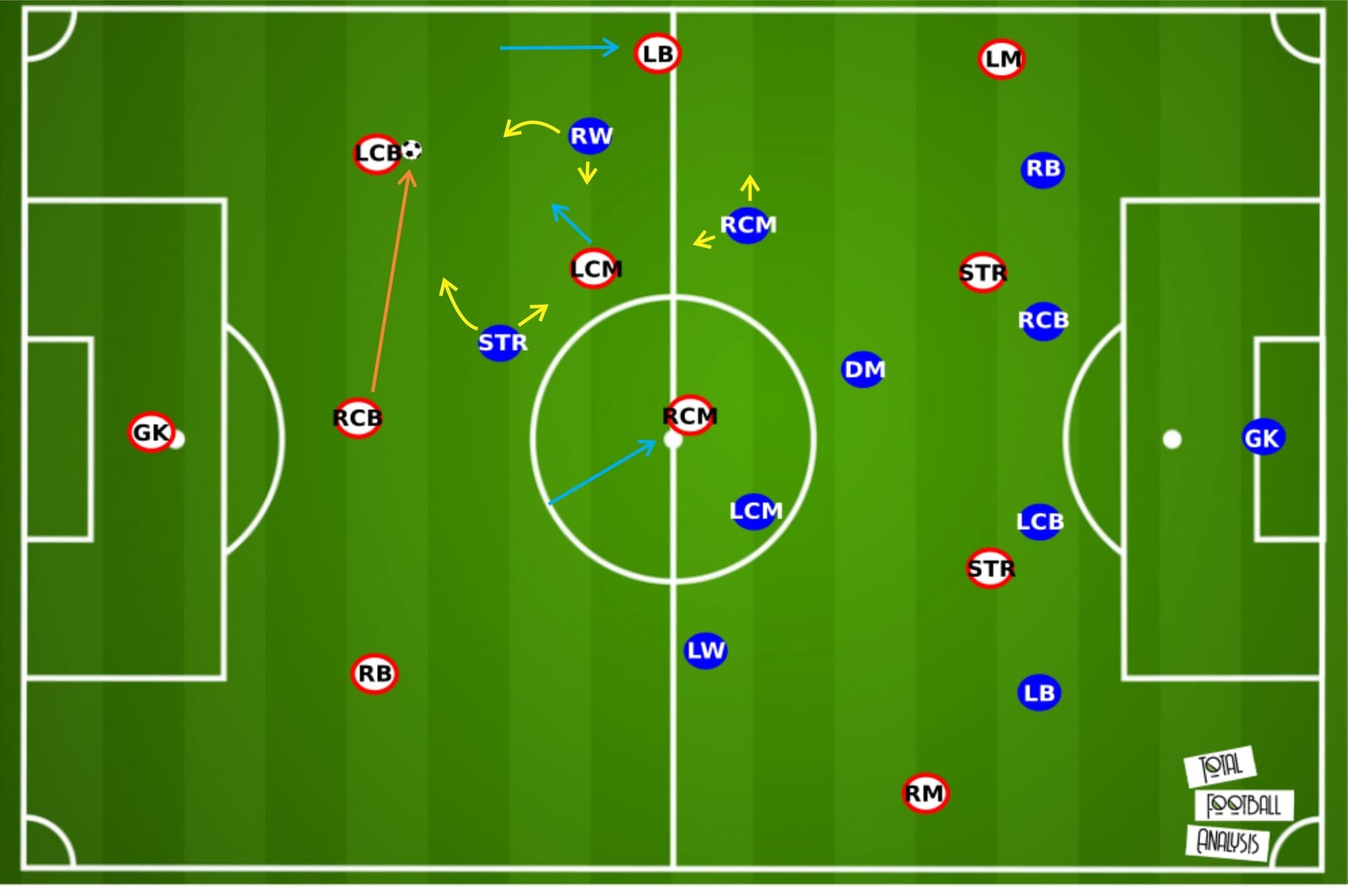
Firstly, they may create a three-man backline. To do this, usually one of the centre-backs will move wider either with or without the ball. The full-back on the same side will then move forward. This will create a rather wide three-man backline. In the situation above, the left centre-back pushes wide and receives the ball there. Meanwhile, the left-back sits higher from his position and the right-back moves narrower. The left central midfielder moves closer to offer support whilst the right central midfielder also tries to move towards the left side but sits in a more advanced position.
Again, this would create some dilemmas for the opposing players which can certainly benefit Ajaccio. The opposing right-winger may hesitate to press the ball carrier or mark Ajaccio’s left central midfielder. The same thing can also be seen with the opposing striker and right central midfielder.
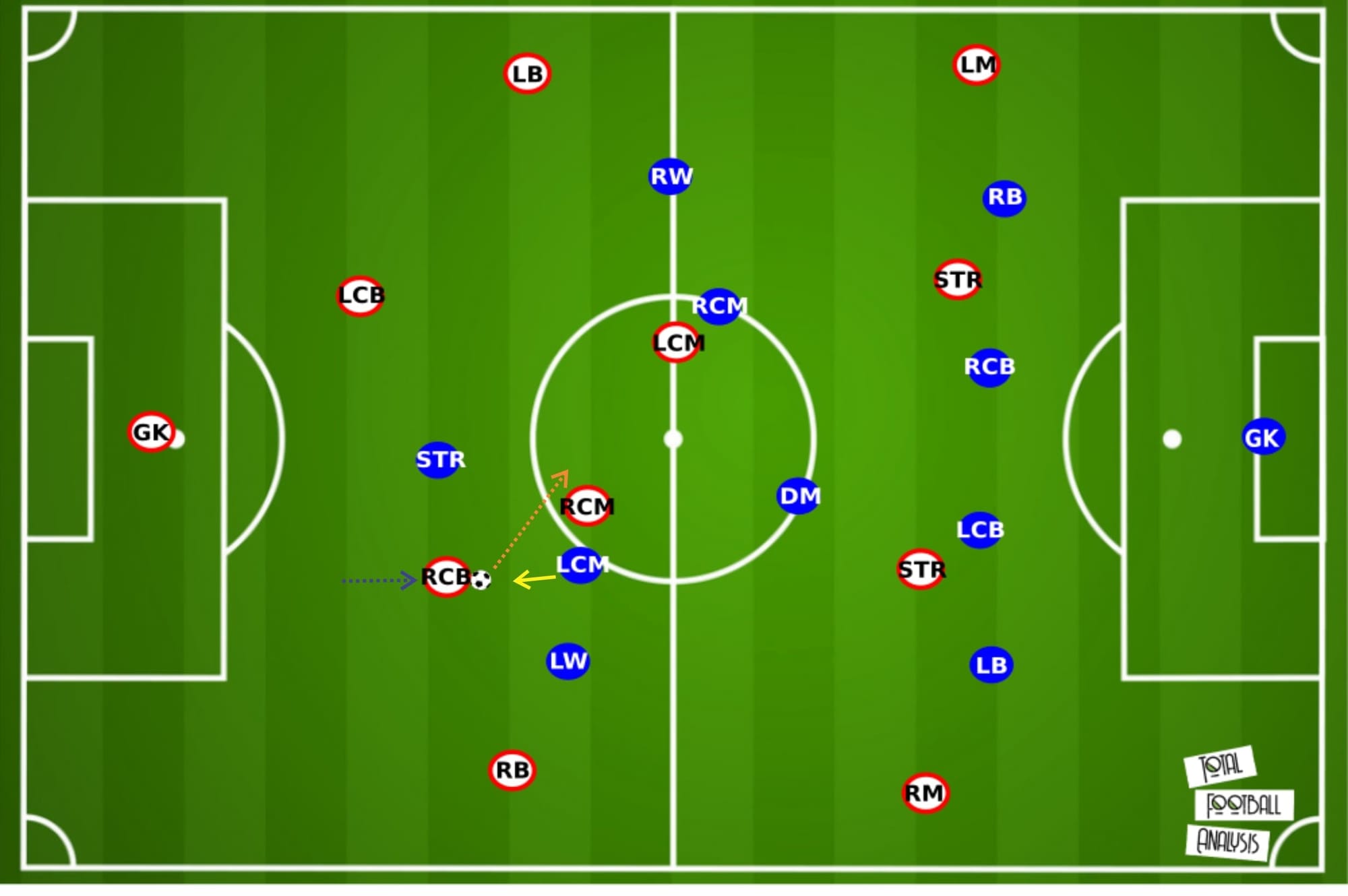
Another way Ajaccio can escape the opposing team’s pressure and progress the ball is by attracting press and opening passing/running lane(s) via dribbles/take-ons. Above, for example, you can see that with no viable options around him, the right centre-back of Ajaccio drives forward with the ball. By driving forward, usually, an opponent will decide to leave his man and engage the ball carrier. As you can see above, the opposing left central midfielder leaves Ajaccio’s right central midfielder and engages the right centre-back. This gives the right centre-back the chance to play the ball towards the now unmarked right central midfielder.
Highly aggressive and intense defensive approach
Ajaccio are the second most aggressive team when it comes to pressing in Ligue 2 behind Lens. They allow an average of only 8.73 PPDA per game, just behind Lens with 8.09 PPDA per game. Pantaloni’s side also rank second when it comes to challenge intensity with 6.8 defensive actions made per minute of opponents’ possession. Compared to Ligue 1 side Lille, Galtier’s side allow an average of 9.31 PPDA per game this season while averaging 5.6 defensive actions per minute of opponents’ possession.
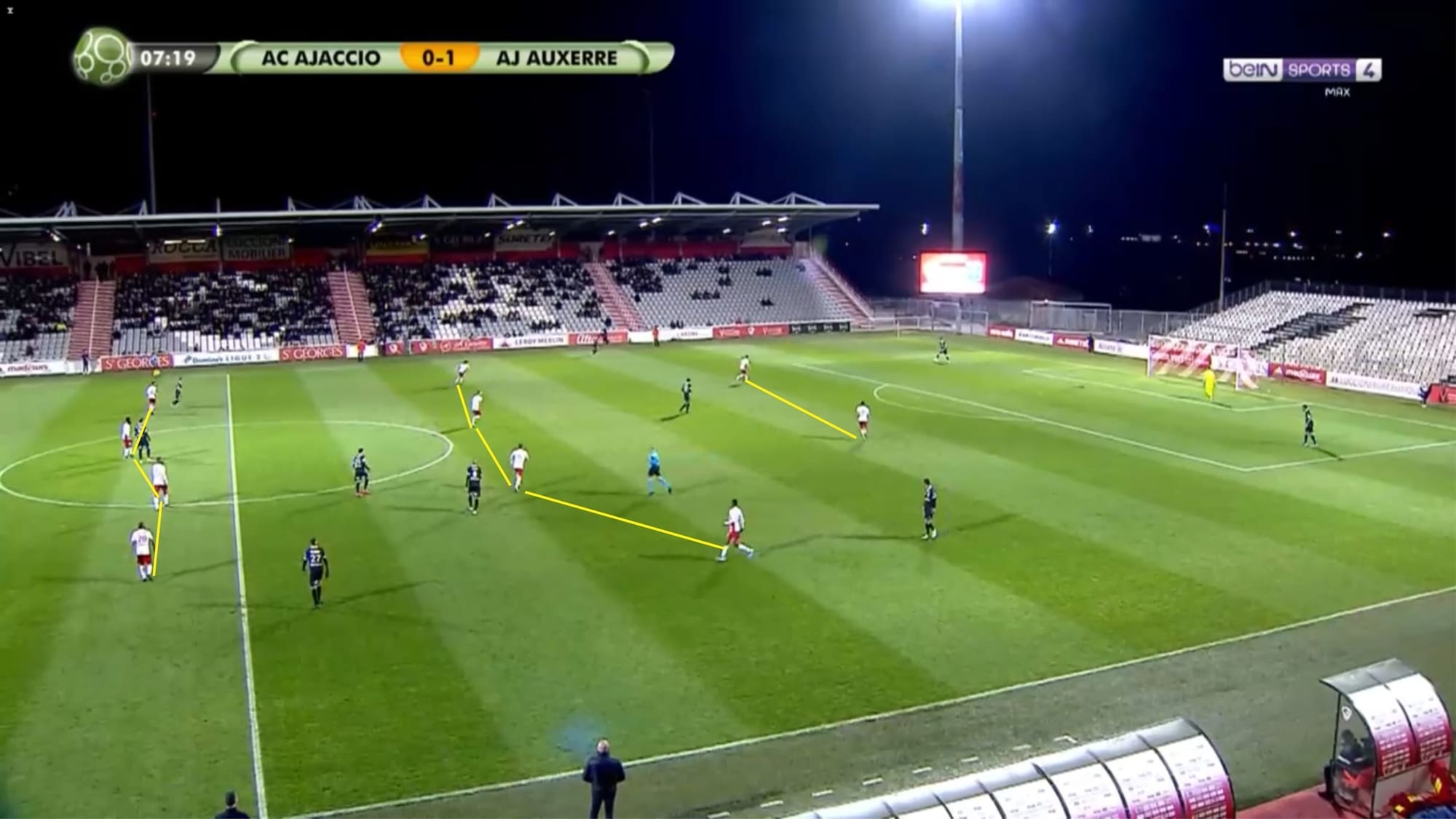
Above you can see Ajaccio’s high block. Ajaccio mainly defend in a 4-4-2 shape with two banks of four and two pressers upfront. They look to defend with a high block and press high. They mainly look to prevent clean progressions and force the opposing team to make a mistake or play long by forcing them to play the ball towards certain areas and then overloading that area and isolating the ball carrier. As you can see, the defensive line will sit high in order to maintain compactness while the two strikers upfront look to press the opposing team’s backline while the front-two look to engage the opposing backline. The team mainly look to maintain their shape in defence and will look to move together as a unit in order to maintain solidity and prevent breakthroughs.
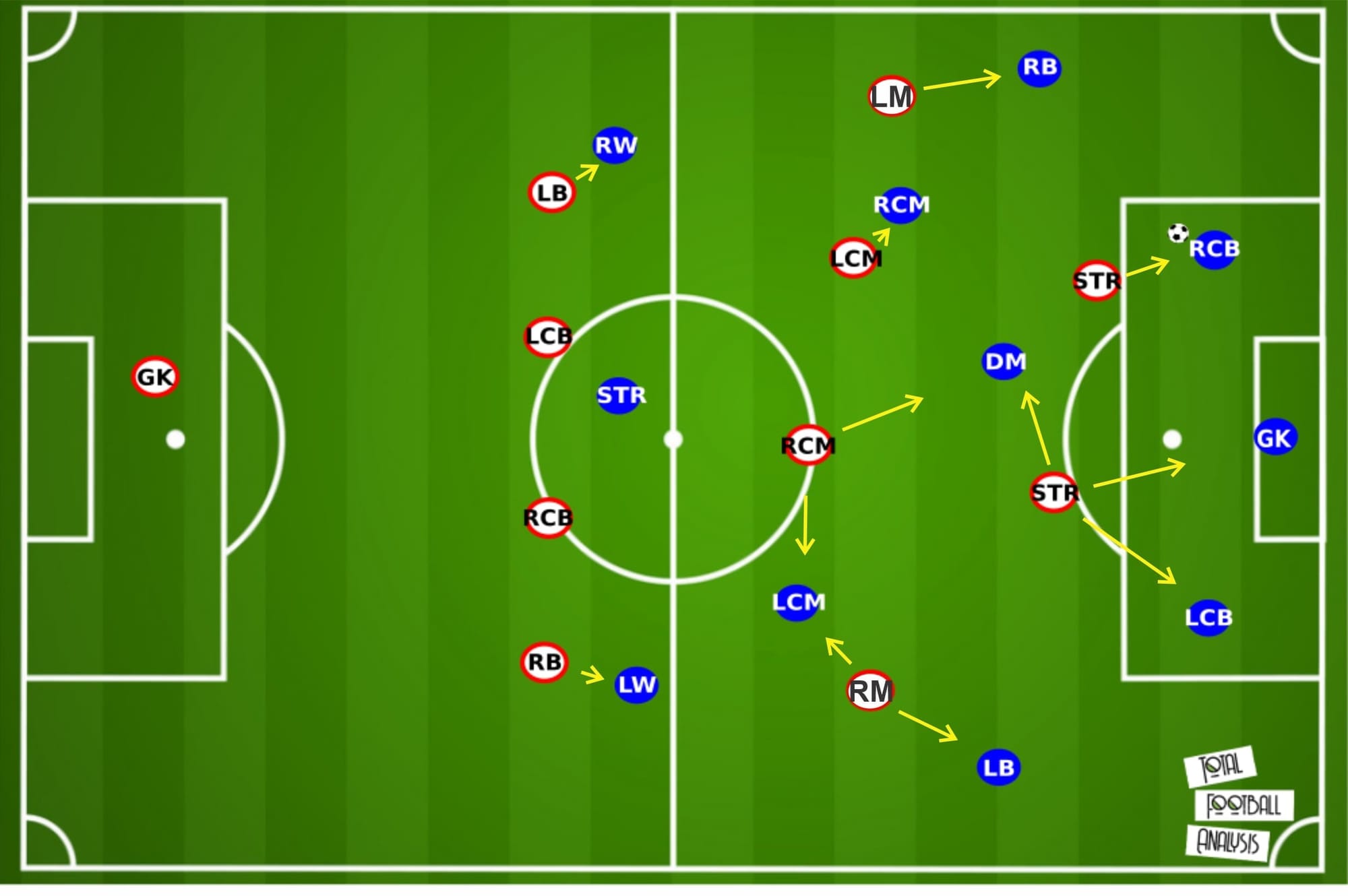
In the illustration above you can see that Ajaccio mainly use a space-oriented approach in defence but certain players may momentarily adopt a man-oriented approach depending on the situation.
As you can see above, the ball-near striker will close down the ball carrier while blocking his passing lane towards the defensive midfielder. The ball-far striker, meanwhile, doesn’t stay very close to the defensive midfielder but rather will look to position himself in space where he could quickly press or intercept the ball if a pass is played towards the opposing left centre-back, goalkeeper, or defensive midfielder. Ajaccio’s left central midfielder will stay tight in order to prevent the ball carrier from playing a pass towards the right central midfielder. Ajaccio’s right central midfielder, meanwhile, doesn’t pick a specific man to mark but rather also positions himself in a space where he can quickly press or intercept the ball if it is played towards the opposing left central midfielder, defensive midfielder, as well as, striker.
Furthermore, Ajaccio’s left midfielder can be seen marking the opposing right-back but doesn’t stay very tight. This usually can give the ball carrier a false sense of security, as if they’re allowing him to play the ball towards the right-back.
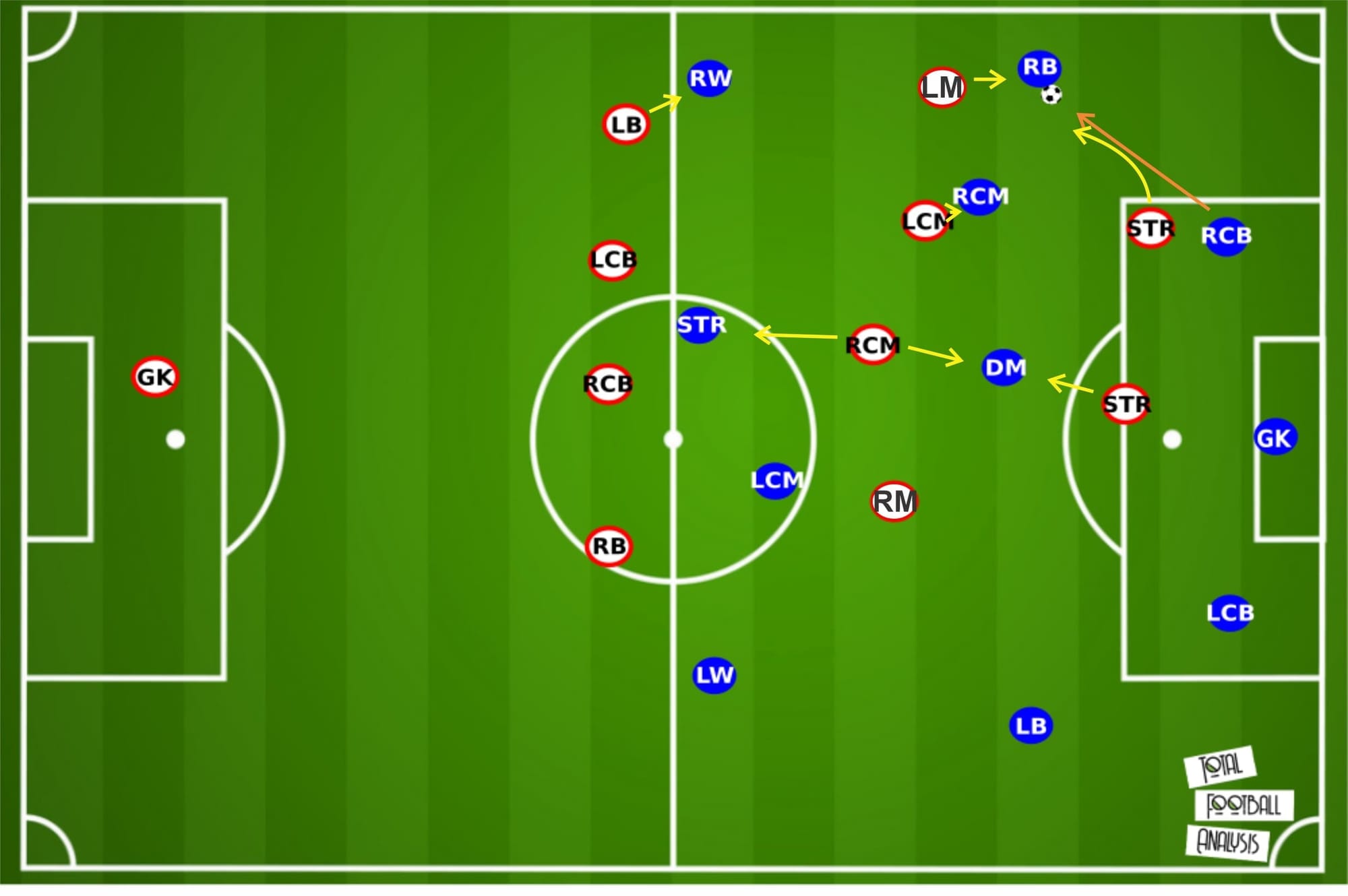
If the opposing right centre-back plays the ball towards the right-back then the ball-near striker will make a curved run to put the opposing right centre-back in his cover shadow and press the right-back. Upon seeing the ball played towards the right-back, Ajaccio’s left midfielder will also quickly close down the opposing right-back. With Ajaccio’s left centre-mid tightly marking the opposing right centre-mid and Ajaccio’s left-back following the opposing right-winger closely, the opposing right-back has very limited options in his hands. Successfully blocking the near options and isolating the opposing ball carrier, Ajaccio can pile pressure on that particular area and force a mistake from the opposing team as well as potentially winning the ball high up the pitch.
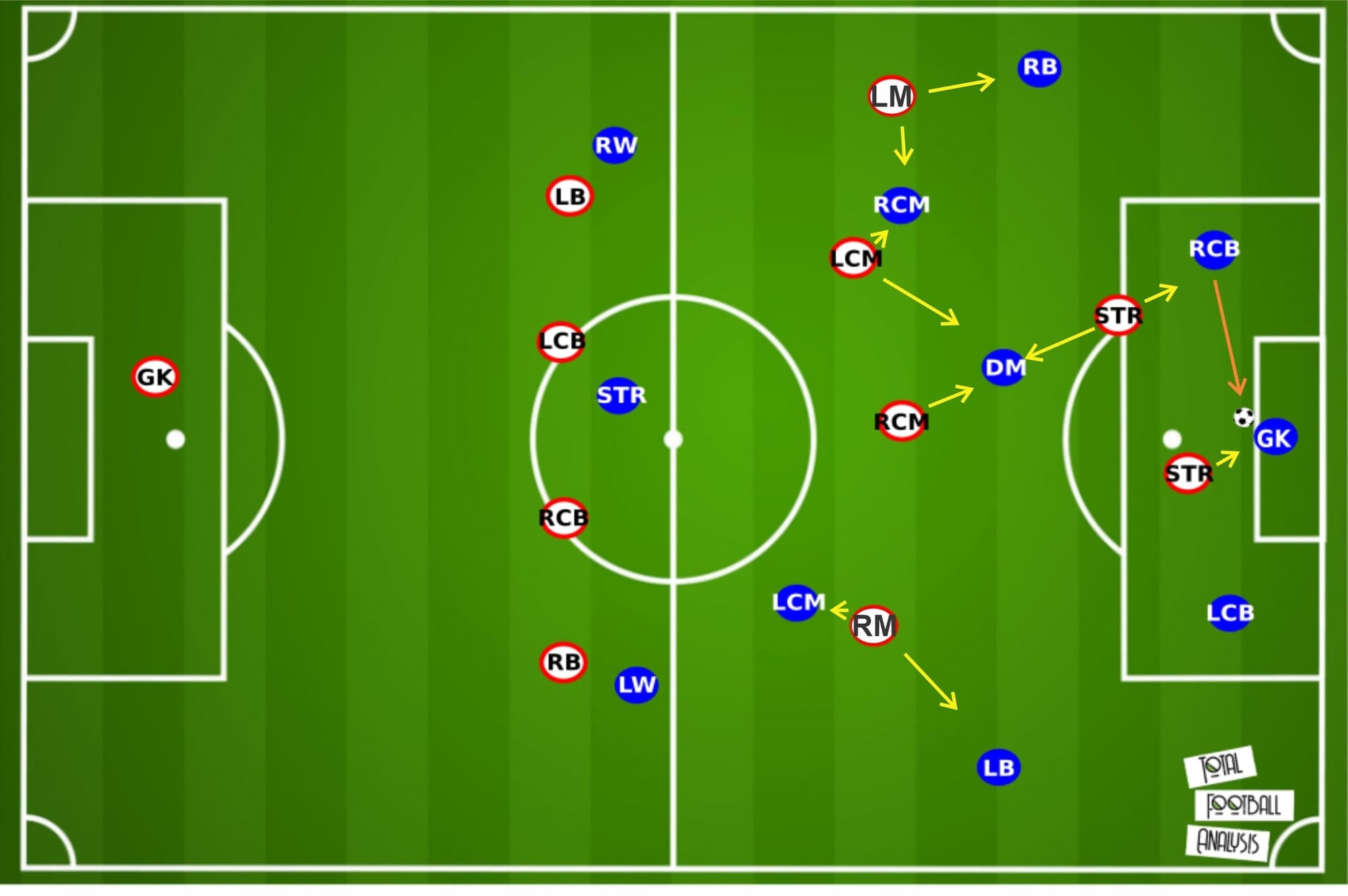
Meanwhile, if the ball is played to the goalkeeper the nearest striker will press the goalkeeper while the other striker positions himself in space to anticipate if the ball is played towards the right centre-back or defensive midfielder. Again, you can see that Ajaccio are largely space-oriented in their defence. Players tend not to stay very tight to one specific opponent but try to find good positions to potentially press an opponent or intercept the ball.
Usually, if the ball is played back to the opposing goalkeeper, he will immediately clear the ball away/play it long as it’s pretty much the safest way to escape the high press.
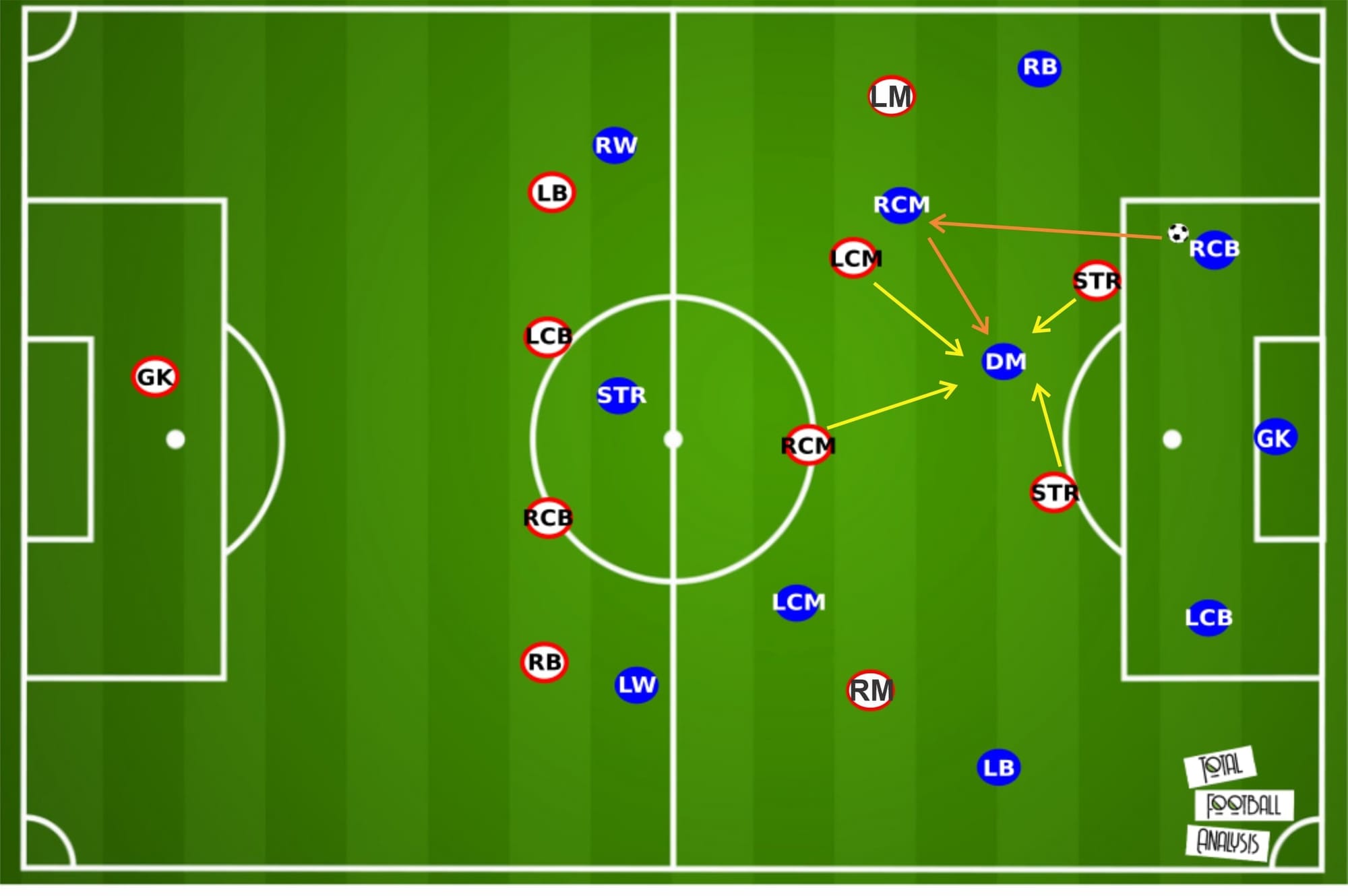
Ajaccio’s structure allows them to set up pressing traps in central as well as wide channels. If the ball is played towards the defensive midfielder, both centre-mids and strikers of Ajaccio will swarm the player, giving him no room to turn/move whilst significantly limiting his options. Again, from there Ajaccio can force a mistake from the opposing defensive midfielder and potentially winning the ball back upfield.
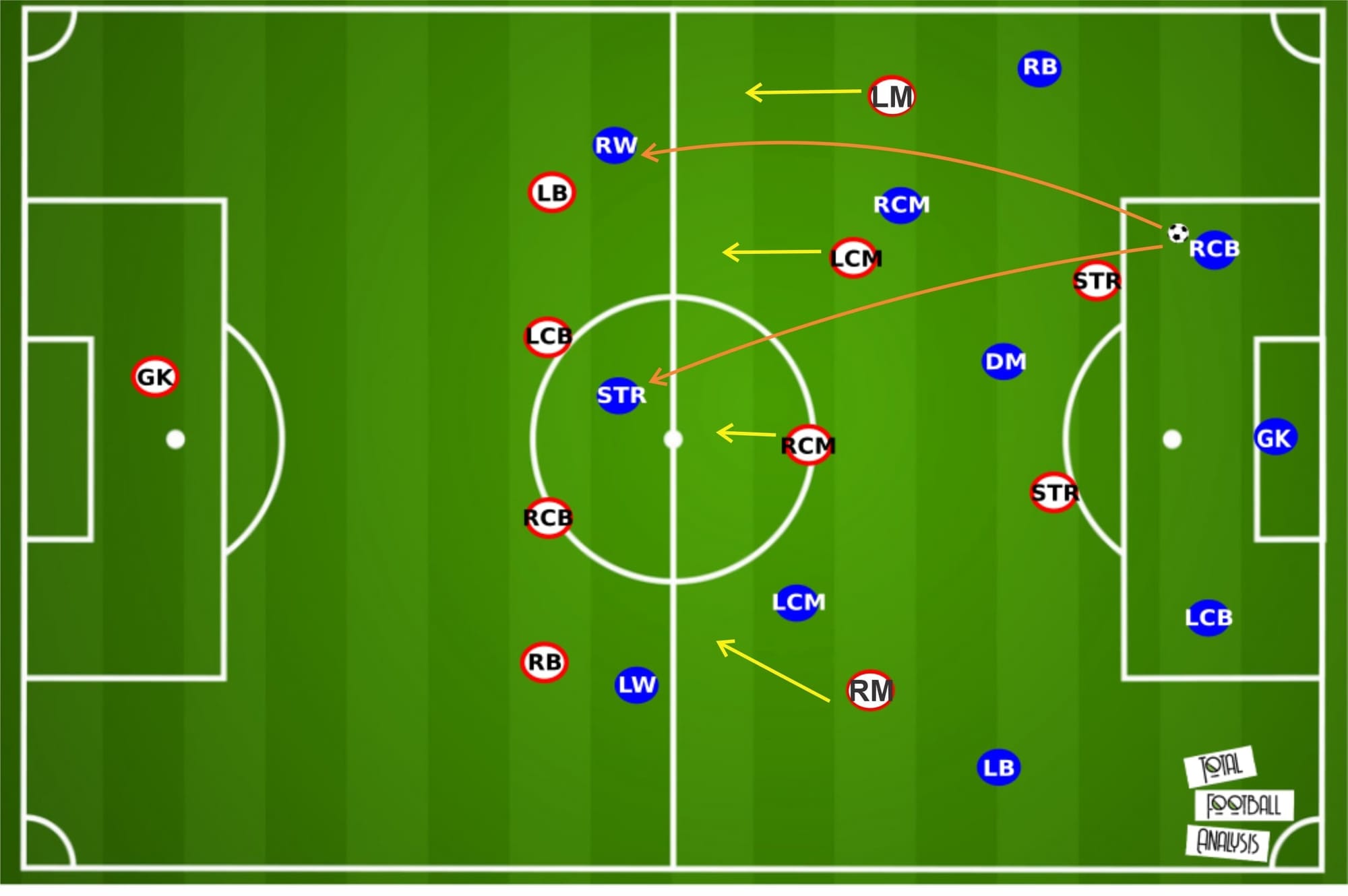
If the opposing centre-back look to immediately play long from the back then the second line of Ajaccio will quickly drop down and move closer towards where the ball will potentially arrive so that the defenders will have multiple good options to lay off the ball to and in case the opposing team wins the aerial battle, they can quickly press and win the second ball. Ajaccio are actually quite strong in defending aerial balls in the middle third. Not because their defenders can win the aerial duels, but they’re usually able to quickly win the second ball.
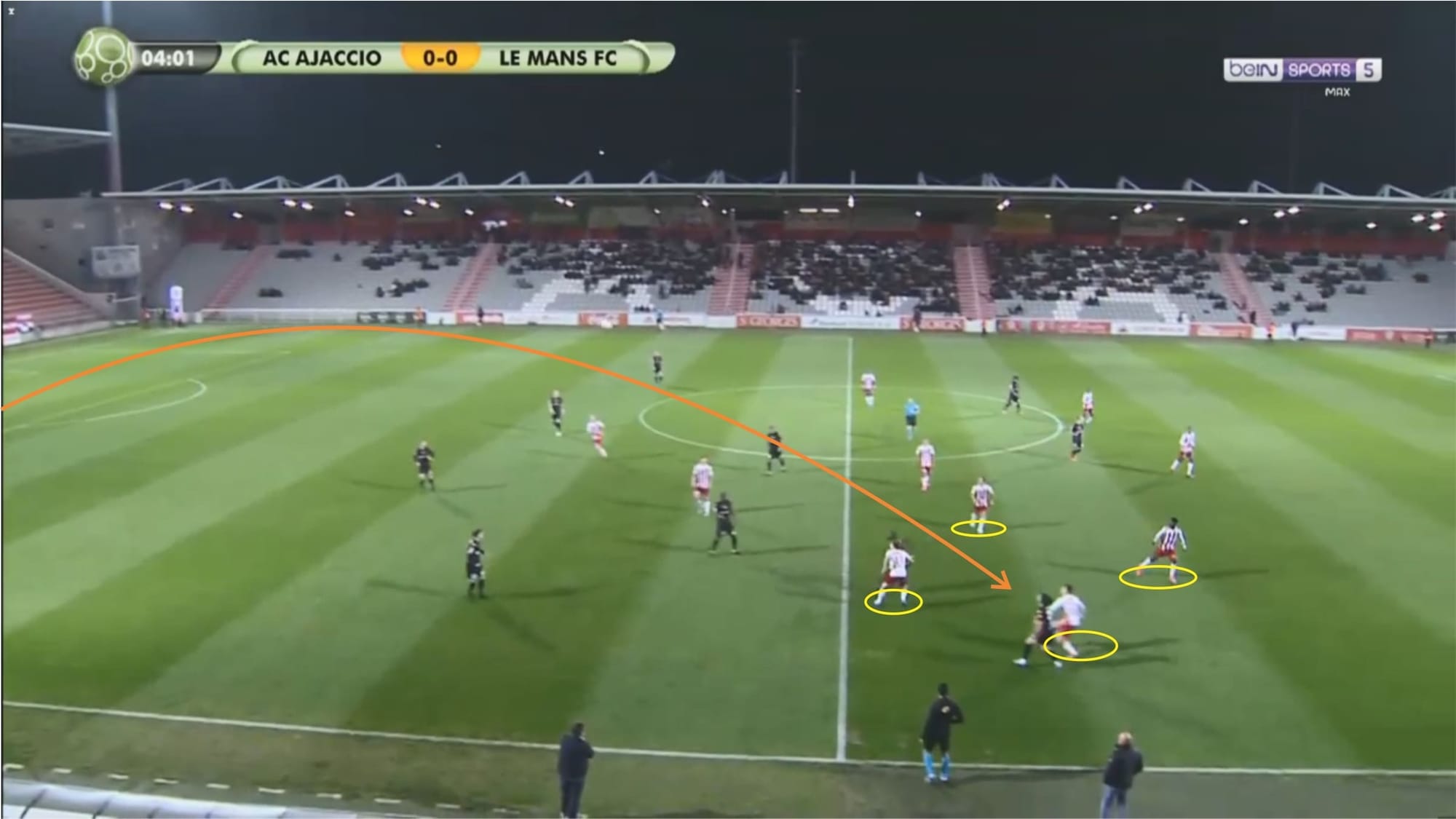
Often, teams would refrain from playing from the back due to the risk of losing the ball due to Ajaccio’s high press. In that case, they will start with a long distribution from the goalkeeper instead. Again, Ajaccio players will always look to move closer to where the ball is potentially going to arrive. From the picture above, you can see that the Ajaccio are very well-structured and their tendency to overload the area where the ball will arrive often give them a lot of advantages in dealing with aerial balls. Again, if the Ajaccio left-back wins the ball, he will have a couple of options to lay the ball off to. On the other hand, if he loses the aerial duel, the players around him will collapse onto the ball and quickly press to win the second ball/recover possession from the opposing team.
If an opposing team still decide to play from the back and successfully worked their way out of Ajaccio’s high press, they will drop back and create a mid-low block. In their mid-low block, they’re a little less aggressive in pressing as they mainly prefer to sit back. However, they will set up pressing traps and once the ball is played into the trap, players will quickly collapse onto the ball which you can see in the image below.
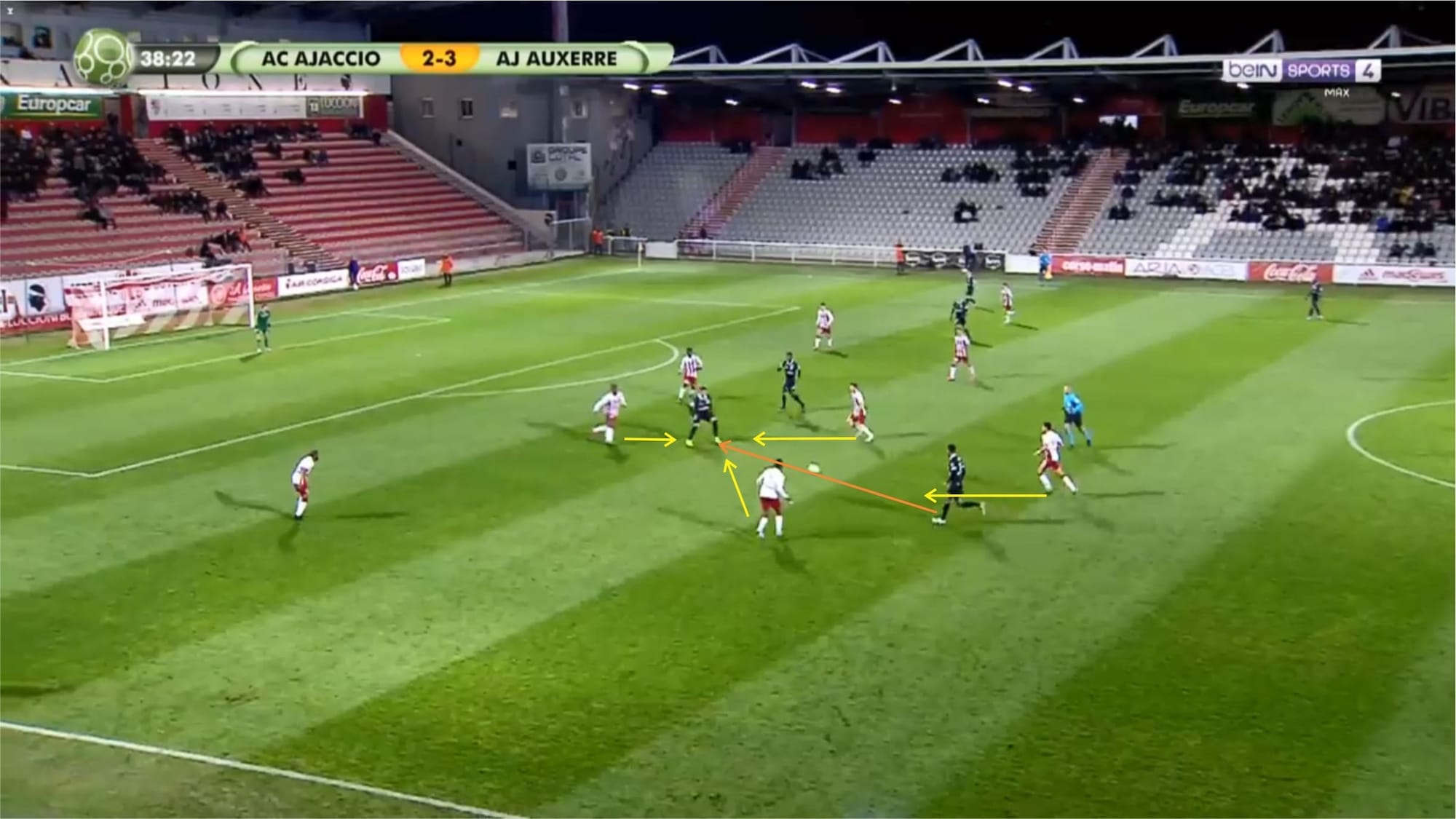
Above you can see Ajaccio players collapsing onto the ball upon seeing the ball being played into the pocket of space between the midfield and defence. The nearest defender will usually jump out of his position to press/intercept the ball whilst the nearest midfielder(s) will close the ball receiver down while cutting off the ball receiver’s passing lanes. Ajaccio’s highly compact and narrow shape makes it very, very difficult for opposing teams to play through the middle and create chances from central areas. However, opposing teams may be able to break through the flanks more often.
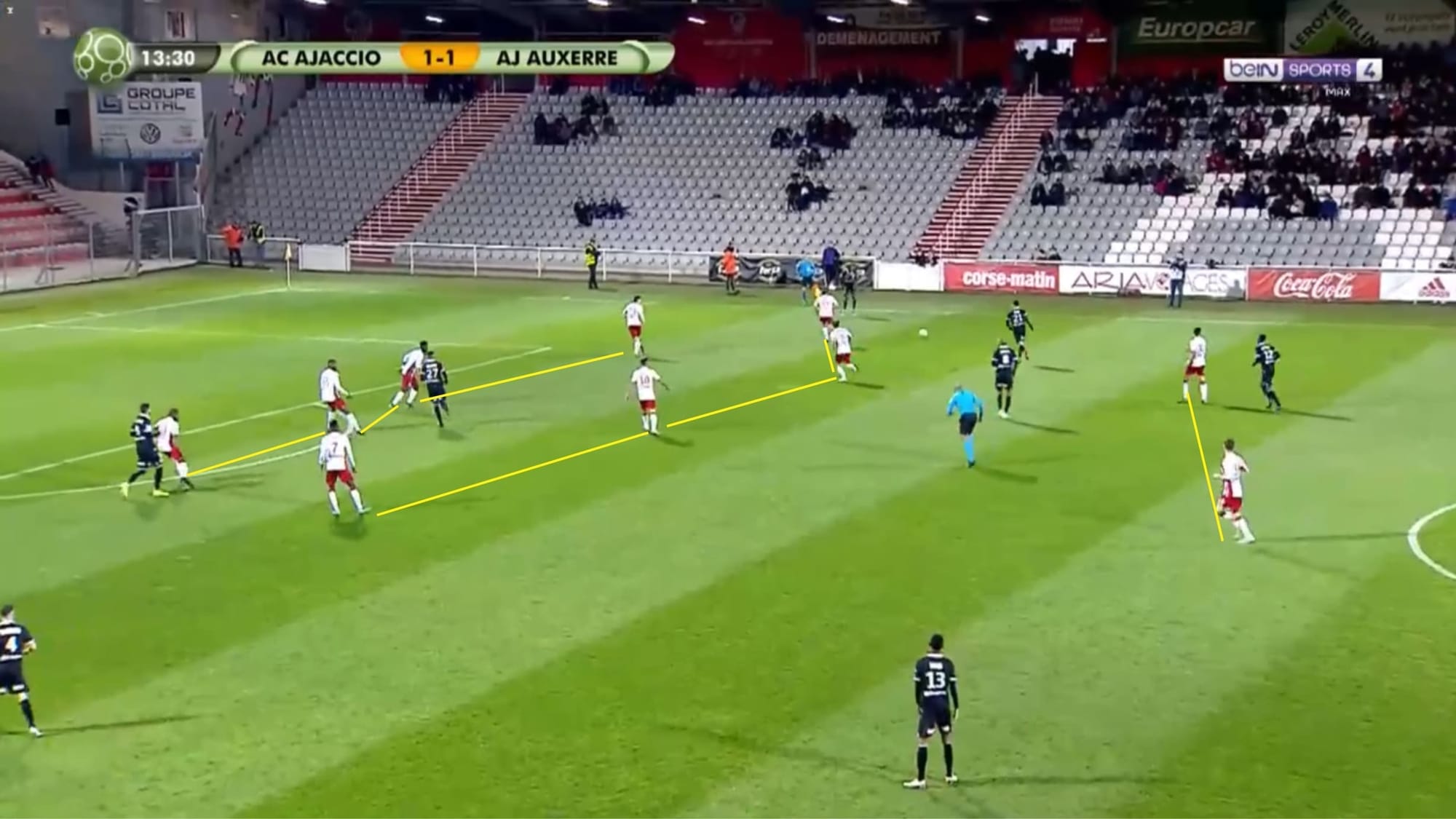
As mentioned earlier in this tactical analysis, Pantaloni demands every player to contribute in defence – even the attacking players. You can see in the image above that the two strikers sit quite deep and will look to participate in pressing as well as marking the opposing players. The two wingers will actively defend the flank as well.
If an opposing team manage to get the ball into an advanced area on the flank, instead of the full-back coming out of position to engage the opposing winger in a 1v1 duel, it’s the wide midfielder who’ll close down the opposing winger and engage him in a 1v1 duel. The Ajaccio full-back, meanwhile, remains tucked in and will step up to press or move into the box to defend the near post once the wide midfielder is beaten. The ball-far wide midfielder, meanwhile, will stay narrow and wait at the edge of the box for spillouts but sometimes may also enter the box to defend the far post.
Transitions
Ajaccio are quick and quite effective in both attacking and defending transitions. A lot of their goals were created from counter-attacks while they also seem to create a lot of chances after recovering possession upfield from counter-pressing situations.
Counter-pressing in defensive transition
Part of the reason why they’re dominant in possession is that they don’t allow the opposing team to hold the ball for too long. Upon losing possession, players quickly execute their counter-pressing tactics and try to win the ball back as quickly as possible or at least try to delay the opposing team’s counter-attack.
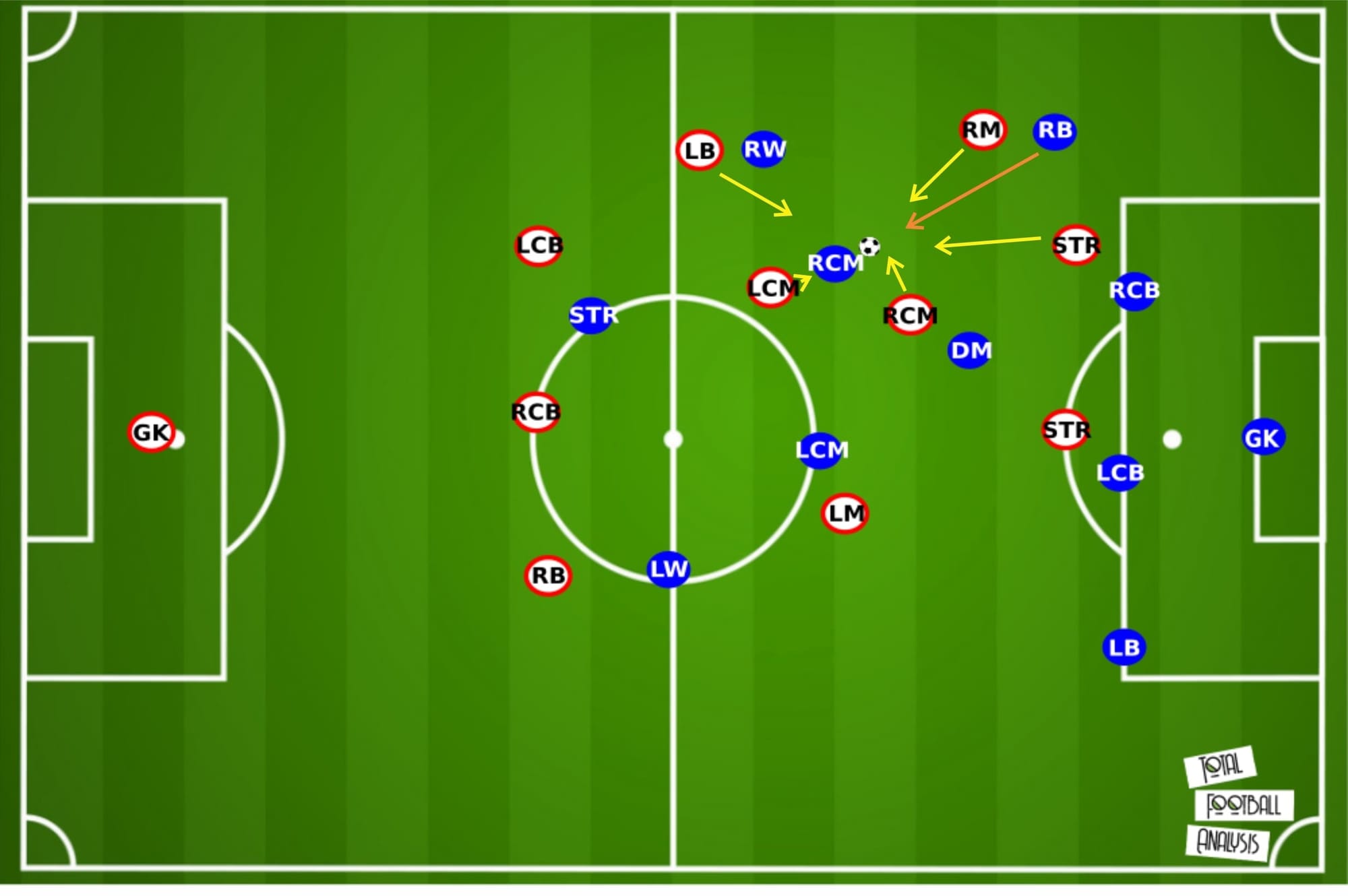
Above you can see Ajaccio’s counter-pressing tactics after losing possession in an advanced position. Ajaccio usually have at least three players for rest defence, consisting of one full-back and two centre-backs. Meanwhile, the two central midfielders will both push forward along with the two wide midfielders and two strikers. As mentioned earlier in the analysis, one full-back will also look to go forward to support the attack depending on the situation.
In counter-pressing, Ajaccio seem to use a leeway-oriented approach. This can be seen as they tend to have multiple players collapsing onto the ball and pressing the ball carrier whilst cutting off passing lanes and restricting space. With very limited space, opposing ball carriers usually have no room to turn and will have difficulties finding good options to play the ball to.
Their approach may look a bit similar to a ball-oriented counter-pressing where players focus solely on swarming the ball carriers actually, however, in this case, Ajaccio’s players will also pay attention to the space and the options around the ball carrier. But rather than picking a specific man to mark or having players mark the passing lanes towards the near options while one or two players press the ball, Ajaccio players may run past their opponents when pressing in order to compress the space around the ball carrier whilst also simultaneously blocking any running or passing lanes for the ball carrier.
Usually, the opposing ball carrier may either rush or delay his decision making and execution. If the ball carrier rushes a pass, for example, Ajaccio players may be able to intercept the ball if it’s not accurate. Some other times, the ball carrier may delay his decision making which would allow Ajaccio players to pile more pressure and eventually win the ball.
Using pacey direct runs and high tempo short combinations in counter-attacks
Moving on to counter-attacks, linking back to their defensive tactics, you can see that the strikers tend to drop quite deep in defence rather than staying high. The presence of both strikers deep inside their own half is certainly very useful in the defensive phase but this means that they can’t really play direct long balls in attacking transitions.
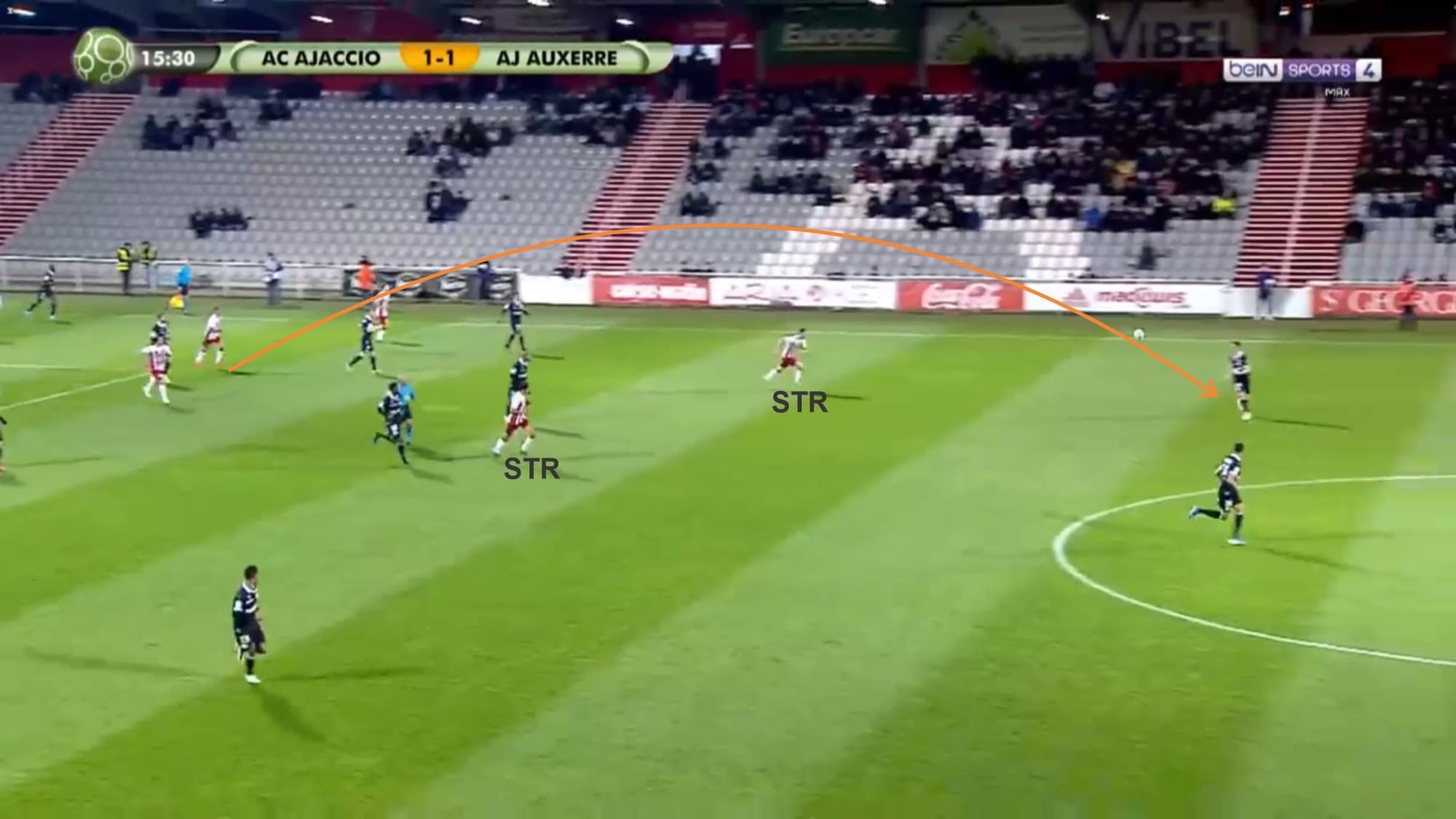
Above you can see an Ajaccio player clearing the ball away but there’s nobody upfield to receive the ball with both strikers sitting deep inside their own half.
This is why Ajaccio tend to launch their counter-attacks with pacey direct runs or quick short combinations instead of using long-range passes.
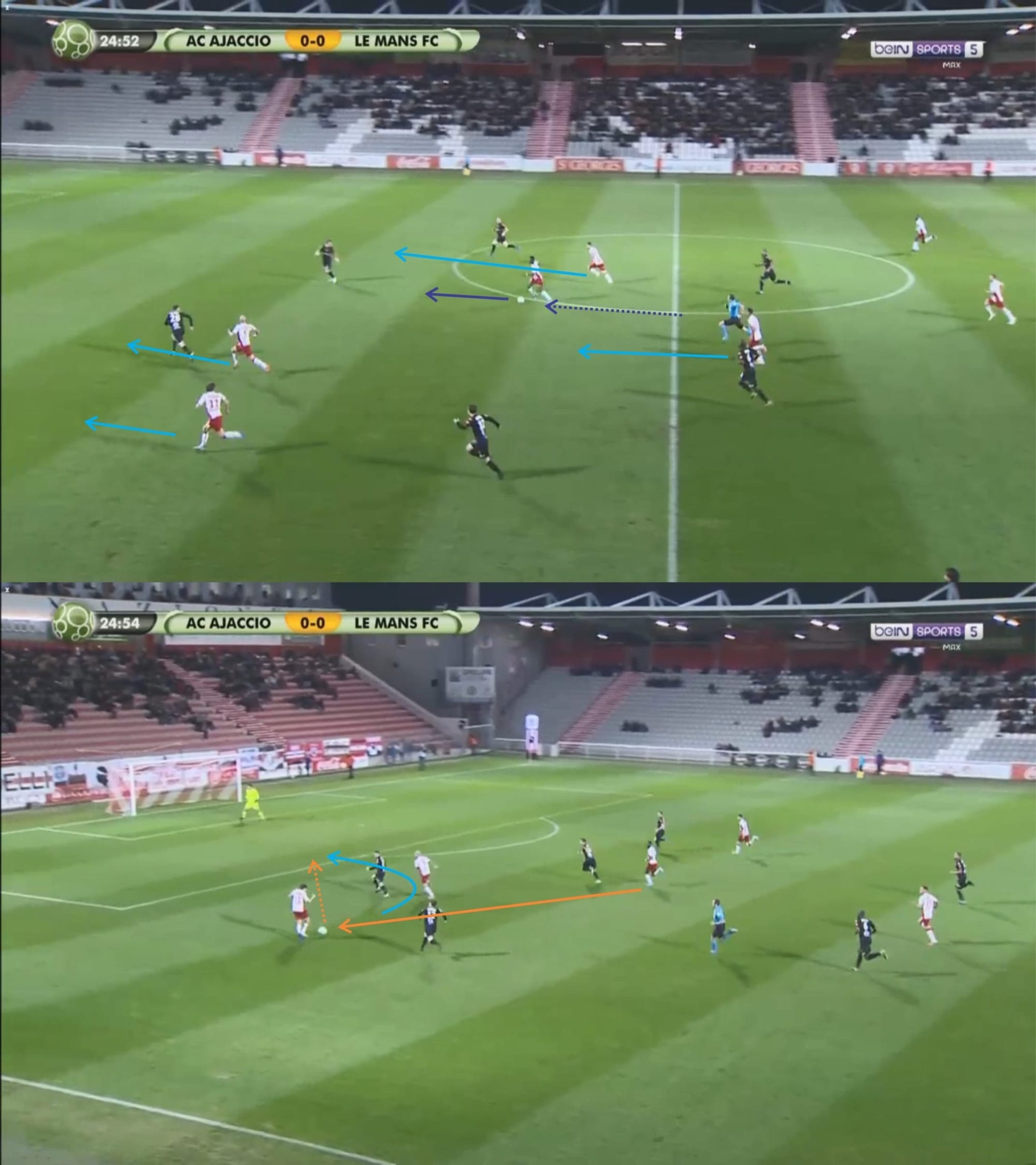
Above you can see Ajaccio executing their counter-attack. After winning the ball in the middle third, Bayala drove forward with the ball. As you can see in the picture, multiple players would also surge forward in counter-attack, trying to: make runs into the back of the opposing team’s defence, allow more space for the ball carrier by occupying a defender and dragging them away from him, and give the ball carrier potential passing option by getting into good positions in advanced areas.
In the second picture, Bayala passed the ball to his left. Courtet dummied and let the ball go past him for Tramoni. The prolific striker also made a run off the shoulder of the last defender and signalled to Tramoni to give the ball into space in front of him. Tramoni, however, misplaced the pass in this case.
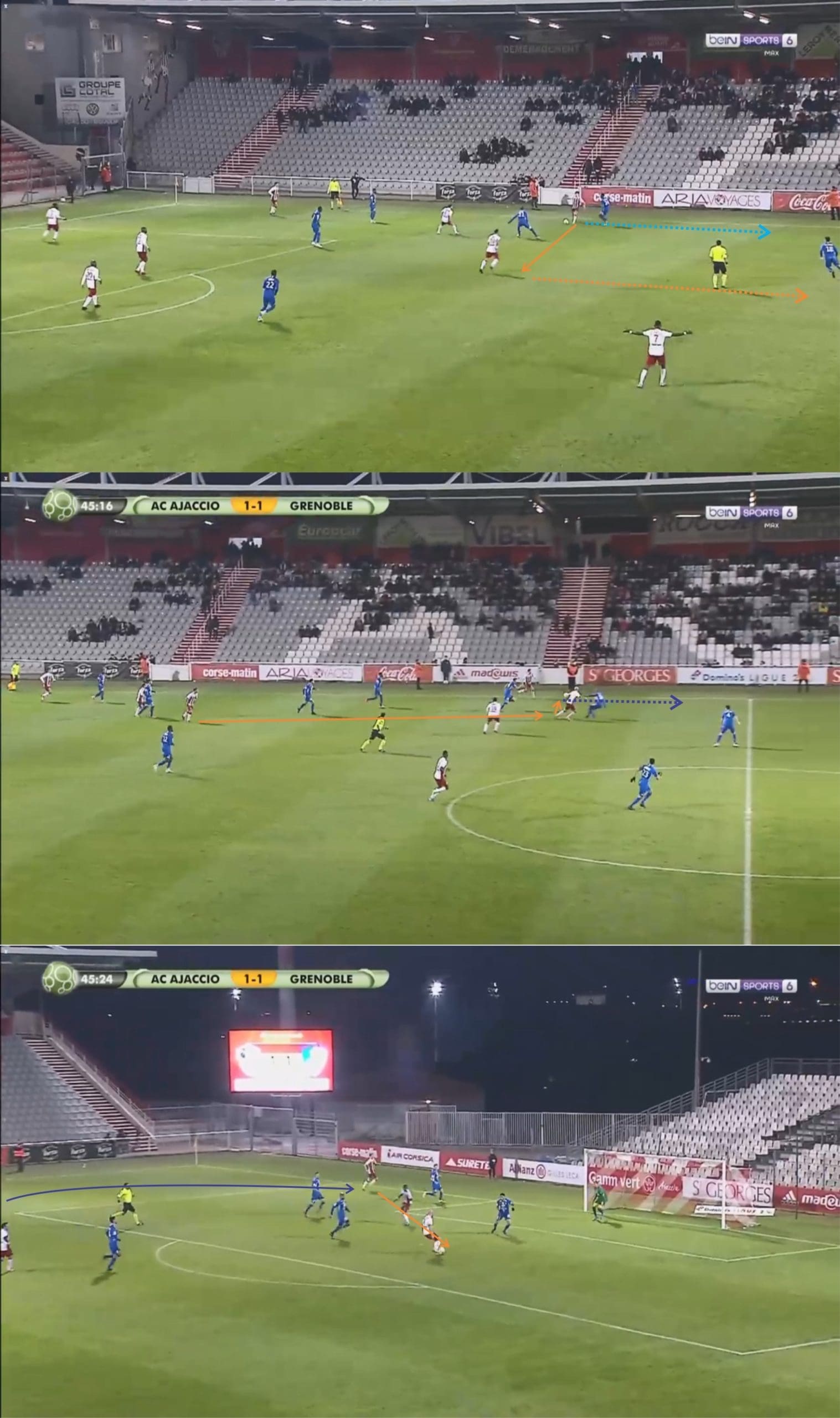
Another common way Ajaccio can launch their counter-attack is as in the example above. They’ll exchange short-medium passes with a high tempo in order to escape the opposing team’s counter-press and get forward quickly rather than playing the ball into space upfront and relying on the pace of their attackers to get to the ball. In the situation above, Ajaccio won the ball deep inside their own half and the ball was passed to Tramoni. Tramoni played the ball short to Laci and immediately surged forward. Laci then passed the ball towards Courtet upfront who laid the ball off onto the path of Tramoni. Tramoni then drove forward with the ball until he entered the opposing team’s box. The young midfielder then delivered a cutback cross towards Courtet who arrived a bit late inside the box. The striker then comfortably finished the move with an accurate strike into the net.
Conclusion
Pantaloni’s Ajaccio have actually been quite an exciting team to watch this season and it will undoubtedly be interesting to follow them in the next season. They were very close to reaching the automatic promotion spot but were very unfortunate to not even have a chance for promotion this season due to the premature conclusion of the league.
Ajaccio will lose several important players from this season such as Bayala, Courtet, Cuypers, and Flips leaving the club due to their loan contract expiring. Club legend who spent time in EPL and La Liga, Johan Cavalli will also retire this season alongside Kevin Lejeune. In addition, Tramoni has been attracting interest from Ligue 1 sides Bordeaux and the recently-promoted Lorient while there are also rumours linking El Idrissy to a move to Marseille. It will be intriguing to see how they will cope with a revamped squad next season but I will certainly be expecting a similar brand of high intensity and exciting football from Pantaloni’s side again.





Comments